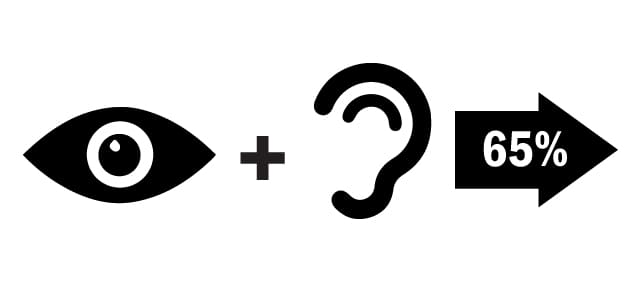If seeing is believing, then effective visuals offer the foundation for juror persuasion.
Research indicates that the use of visual aids results in decreased learning time, improved comprehension, enhanced retrieval, and increased retention. Studies show that after a 12-hour period, individuals only recall about 10% of information that is presented aurally.
Undoubtedly, that number diminishes further with jurors, who make decisions days, weeks and sometimes months after the presentation of evidence. If, however, the same information is accompanied by a visual image, retention rates rise to between 65% and 85%, studies show.
The use of visual aids is commonplace during jury trials such as product liability and personal injury cases. It is perhaps less obvious with commercial litigation cases, where there isn’t necessarily a product or accident scene that readily lends itself to an illustration. However, it is precisely this abstractness that dictates why graphics are of importance in commercial cases, with actions ranging from antitrust and breach of contract to class actions and shareholder derivative suits. The sheer complexity and range of case types means commercial litigators face a distinct challenge in boiling down complexities to enable jurors to efficiently focus on the key legal and factual issues.
These disputes between businesses, government entities, and groups of individuals require educating and persuading jurors on the nuances of commercial transactions, financial documents, and dense legal code sections. When myriad, these nuances can become complicated to explain to a jury in succinct, persuasive fashion, and providing jurors something concrete to solidify their understanding can provide for a serious advantage if you are doing it and your opponent is not.
Here are four tips on how to effectively utilize graphics with these high-stakes matters.
1. Use an Immersive Approach
A 2011 study using 1,375 mock jurors tested five types of graphics presentation methods in the courtroom:
a. No litigation graphics
b. Flip chart graphics created live
c. Static graphics
d. Animation and
e. Immersive style in which animated and static graphics were in constant use
The results revealed that graphical immersion yielded the best results. Providing the jury something to look at whenever possible, as opposed to showing documents, graphics, images, etc. only periodically as deemed necessary, enhanced juror response the most. Information that is both told and shown to jurors is thought to engage separate processing cortexes of the brain –the auditory and visual – which results in a sharing of cognitive load, and thus enhanced processing and retrieval of that information.
2. Help Jurors Help You
Research indicates that being confused or feeling intellectually inferior is psychologically uncomfortable for us. This feeling can be very easy for jurors to experience, as they are bombarded with the complexities of commercial litigation, and they may respond with resentment and antagonism toward the presenting attorney.
To counter this, boil complex arguments down and present as much as possible using visual aids. In particular, use charts and diagrams to improve comprehension of quantitative data such as business financials, and animation to aid understanding of dynamic processes. The example below depicts how multiple transactions scattered across a multitude of documents and spreadsheets were boiled down to a single sum, aiding jurors with their damage calculations. This also makes it easier for jurors to “believe your math,” and if these graphics are used consistently and reliably throughout trial, they can reinforce the aforementioned immersion approach.
3. Invoke Emotions for a Lasting Message
Pairing an emotional message with a visual helps individuals to more deeply ingrain information, because visual memory is encoded in the same area of the brain as emotions. Because visual stimuli and emotional responses are easily linked, they more readily form memories. So to have a lasting effect, pair your graphics with particularly poignant elements of your story. You can also utilize negative depictions of the other side to harbor distaste in jurors’ minds.
4. Be Mindful of Order Effects
Research shows that recall and recognition of textual and pictorial information is influenced by the order the information is presented. In a low prior knowledge scenario, as with jurors, viewing a picture before text fostered text-based recall, because this sequence of presenting information increased the likelihood of creating connected memory representations.
If, however, you want a picture to stick with the jurors, presenting the picture after text has been shown to foster recall and recognition of pictorial information. These approaches were also found to be superior to simply presenting the text twice or the picture twice.
Graphics are a key aspect of any litigation, especially with complex matters. By using an immersive approach, assisting jurors with comprehension, invoking emotions when appropriate, and recognizing the effects of presentation order, you can increase the efficacy of your trial graphics. Effective use can mean the difference between confusing and frustrating jurors or rallying them to your cause.




 />i
/>i




